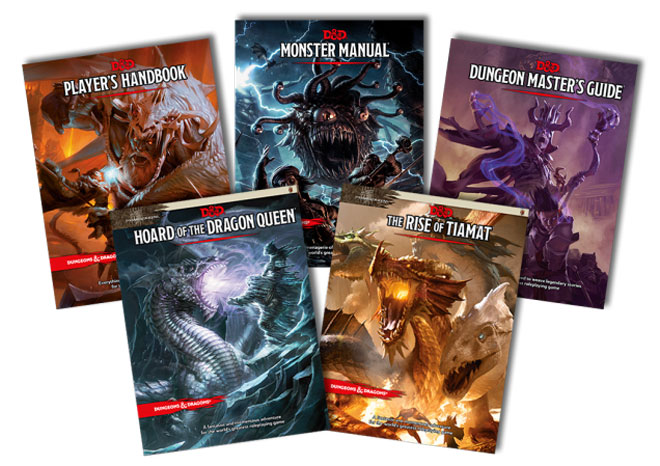The Meeple’s Eye View is an in depth review of one of the many games in our board game library. As the Malted Meeple has become Northeast Ohio’s role playing game hotspot we have decided that it is time to start reviewing some of our favorite role playing systems as well!
Few roleplaying games can claim the title “the world’s greatest roleplaying game”, and fewer still have the gravitas to publish it on their cover. Dungeons & Dragons 5th Edition is such a game. Published in 2014 by Wizards of the Coast, players are invited to take up swords, bows, and spell books in the latest edition of Dungeons & Dragons.
The Players Handbook offers players a plethora of options when building characters. For those who have played Dungeons & Dragons before many of these options may sound familiar. Players start by selecting their stats via point buy or using the standard array. After which they select a race such as noble Dwarves, graceful Elves, proud Dragonborn, devious Tieflings, and Humans. Each race has its own special abilities and attribute bonuses.
Next players choose a class such as: Barbarian, Cleric, Rogue, Wizard, or Warlock. Each class has its own unique abilities which may include magic spells, extra attacks, or other effects. The character’s class determines his role in the party. Some classes make good healers, while others excel at protecting others or dispatching large groups of foes. These classes start with a number of skills, armor, and tools with which the character is proficient; and also determine starting equipment and hit points.
Finally the player determines the character’s background. This represents the character’s life experience before he became an adventurer, and offers the character more starting equipment, special abilities and proficiencies with skills and tools. The addition of backgrounds is probably the biggest change to character creation in 5th edition. In this edition, the emphasis seems to be placed on creating and playing a character as opposed to some previous editions which focused much more on mechanics.
The core mechanic of Dungeons & Dragons remains unchanged. When the Dungeon Master calls for a skill check, players roll a 20 sided die and add any bonuses they may have from their stats or proficiencies. If the check is sufficient then the outcome falls in the character’s favor. If the check fails then the character may find themselves in an unfavorable position.
There are a few significant changes in this edition of the venerable roleplaying system. My favorite is the addition of the advantage/disadvantage mechanic. Simply put, if the character is attempting a task in a way that would give him advantage, he rolls two 20 sided dice and choses the highest. If the character is performing a task while they are hindered, they may have disadvantage. In this case they roll two 20 sided dice and are forced to take the lower number. This is a drastic change from previous editions which included unnecessary amounts of math when performing complex actions.
Another major change I like is that players get access to their classes’ special abilities at lower levels. Simply put, in the new edition you can do cool stuff sooner. If you wanted to play a spell-slinging fighter, you can chose that path at level 3. In previous editions, players would need to wait much longer to accomplish such a feat.
I also like the fact that there are fewer skills and no more skill points. This makes changing a character from one level to the next much easier. This also means that there are fewer of those extremely situational skills. For those of you who are concerned with skill growth, fear not. Any of the skills that you are proficient with will continue to grow as your proficiency bonus increases with your level.
As a player, the only thing one needs to play the game is a Player’s Handbook. The Players Handbook is a 300 page full color rulebook which is beautifully illustrated with character inspiring artwork throughout. It contains all of the rules the players will need to play a character in Dungeons & Dragons. A Dungeon Master will need to pick up a Monster Manual and a Dungeon Master’s Guide to supplement the Player’s Handbook. Both of these books are full color with fantastic artwork and are essential to running a campaign. There are also several well written modules available for Dungeon Masters to lead their players through.
I have only one minor quibble with the new edition of Dungeons & Dragons. Some of the new class paths seem somewhat limited, while others seem to be unapologetically better than others. Some of the paths grant the players amazing abilities, while other paths seem lackluster by comparison. I suspect that this will be solved with the release of supplemental materials.
Much of the new edition is set against the familiar backdrop of the Forgotten Realms. In fact all of the modules currently available take place along (or under) the famous Sword Coast!
As for my final verdict: it is my honor to give Dungeons & Dragons 5th Edition two scimitars high!
If you would like to experience Dungeons & Dragons 5th Edition first hand, you’re in luck! This happens to be one of our favorite systems here at The Malted Meeple, and you will find several tables of guests enjoying Dungeons & Dragons every Wednesday evening. Stop in and join us! If you are interested becoming one of our Dungeon Meeples please contact us at info@maltedmeeple.com.
Karington Hess is a lifelong gamer whose passions for hospitality and all things game-related led him to Ravenwood Castle, where he served as an Innkeeper before joining The Malted Meeple. When not pouring beers, crafting milkshakes, or teaching boardgames, Karington can be found behind the DM’s screen, weaving intricate stories for his fellow gamers.

